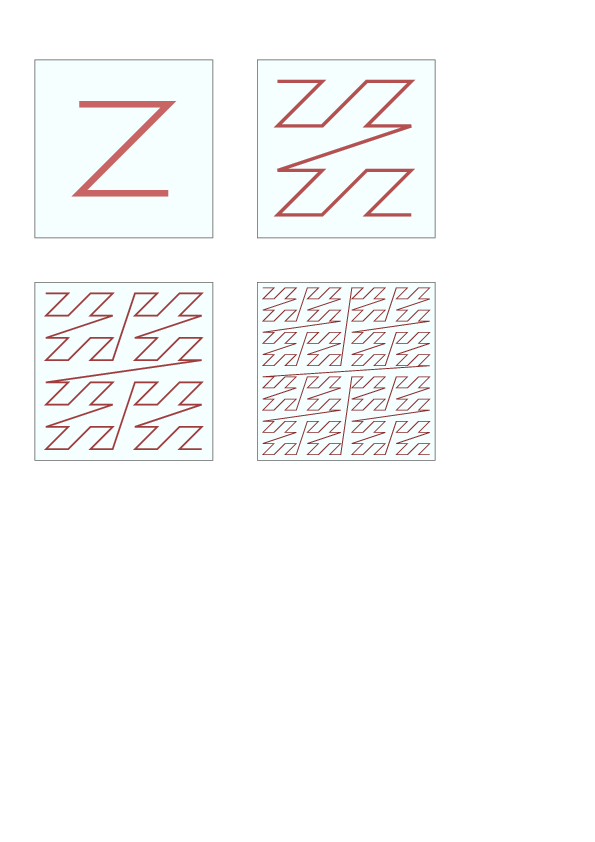APT-CPP
Morton order matrices in C++
Rupert Nash
r.nash@epcc.ed.ac.uk
Source for this can be obtained from Github. Get a new copy with:
git clone https://github.com/EPCCed/APT-CPP
or update your existing one with
git pull
then you can
cd APT-CPP/exercises/morton-order
The Morton ordering (or z-ordering) of a matrix lays out the elements along a recursive z-shaped curve, as shown in the figure of four iterations of the Z-order curve (from Wikipedia).

You can compute the Morton index z from the x- and y-indices (i
and j respectively) by interleaving their bits. An example is shown
in the table.
| 0 | 1 | 2 | 3 | |
|---|---|---|---|---|
| 0 | 0 | 1 | 4 | 5 |
| 1 | 2 | 3 | 6 | 7 |
| 2 | 8 | 9 | 12 | 13 |
| 3 | 10 | 11 | 14 | 15 |
Mapping between x-y indexes and Morton index for a 4 by 4
matrix. Decimal on the left and binary on the right.
| 00 | 01 | 10 | 11 | |
|---|---|---|---|---|
| 00 | 0000 | 0001 | 0100 | 0101 |
| 01 | 0010 | 0011 | 0110 | 0111 |
| 10 | 1000 | 1001 | 1100 | 1101 |
| 11 | 1010 | 1011 | 1110 | 1111 |
Mapping between x-y indexes and Morton index for a matrix of size
4-by-4. Decimal on the left and binary on the right.
The advantage of laying out data in this way is that it improves data locality (and hence cache use) without having to tune a block size or similar parameter. On a modern multilevel cache machine[^1], this means it can take good advantage of all the levels without tuning multiple parameters.
(E.g. an ARCHER node has L1, L2, and L3 caches, and the RAM is divided into two NUMA regions. If using a PGAS approach one can view local RAM as a cache for the distributed memory - i.e. 6 levels!)
This exercise will walk you through a simple implementation.
I have included implementations of the functions that do the
“bit-twiddling” for translating between a two-dimensional x-y index
and the Morton index, in the file bits.hpp. These are reasonably fast,
but can be beaten if you are interested to try!
In what follows each section corresponds to a subdirectory with the same number.
Implement the underlying data storage and element access
Go to the step 1 directory:
cd APT-CPP/exercises/morton-order/step1
Using the partial implemenation in matrix.hpp, your task is to
implement the allocation (and release!) of memory to store the data and
to use the helper functions from bits.hpp to allow element access. You
will need to implement a number of member functions (marked in the
source with \\ TODO) and add whatever data members are needed (marked in
the same way).
There is a test program test_matrix_basic.cpp which runs a few sanity
checks on your implementation (and similarly with test_bits.cpp). The
supplied Makefile should work.
Implement a basic iterator to traverse the matrix in order
Go to the step 2 directory:
cd APT-CPP/exercises/morton-order/step2
I have a potential solution to part 1 here, but feel free to copy your implementation into this.
The exercise here is to complete the matrix_iterator class
that I have started. I’ve provided most of the boilerplate to have
this work as a “bidirectional iterator”. See
http://en.cppreference.com/w/cpp/concept/BidirectionalIterator for
full details of what this means, but basically it’s one that can move
forward and backward through the data.
Again, the things that need added are marked with \\TODO. The most
important thing to think about is how you will refer to the current
position and be able to traverse through it efficiently in Morton
order - the performance should be identical to looping over a raw
pointer!
Adapt your code to work with any datatype using templates
This part and the next to be attempted after the lecture on templates!
In the step 3 directory, and using your solution from part 2, refactor
the matrix class into a template class with a single parameter, the
type of the contained element. Remember that template definitions have
to be available to the compiler when they are used by client code!
Places you will have to modify the source are marked with TODO.
Allowing iteration over const matrices
The current implementation of matrix_iterator does not work if the
matrix being used is const. We could implement a new class
template matrix_const_iterator<T> which would be a copy and paste of
matrix_iterator but with lots of const added.
In the step 4 directory, adapting the matrix_iterator template to
work for T and T const and use this appropriately in the matrix
template. Places you will have to modify the source are marked with
TODO.